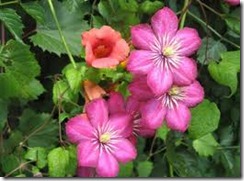-
Originating from the Greek word "klema," clematis literally means "climbing," according to the Garden Action website. Anemones, peonies and buttercups are all from the same family as the clematis. Native to the northern hemisphere, clematis is hardy in the cooler regions of the United States.
Types
-
With more than 400 varieties available, each with its own distinctive color, choosing clematis for your area is not difficult, according to the Garden Action website. Larger areas such as walls are ideal for the traditional Clematis Montana, a strong-growing strain. In smaller areas, almost any variety of clematis will be appropriate. The President and Nelly Moser, two varieties that are most common and generally available in wide areas, enhance an area with beautiful spots of color. For more emphasis on greenery, try one of the Clematis armandii strains with glossy, evergreen leaves; these strains require a more protected area. The Macropetala or Alpina strains of clematis, such as the Alpina Helsingborg and the Macropetala Markham’s Pink, work well in more exposed areas due to their low maintenance and hardiness.
Planting Conditions
-
As a climbing plant, the clematis requires something to grab onto, such as a wall, trellis or fence. Bury the crown of the clematis at least 2 inches below the ground’s surface, which encourages more stems to grow up from the crown. More stems promote faster growth and make the clematis less susceptible to disease, according to the website Lorraine Flanigan’s GardenMart. Water frequently, as new plantings require plenty of water. If necessary, gravel the bottom of the hole or add sand to the soil, as good drainage is a must for clematis plants. Plant ground cover, such as hosta, to provide shade for the roots of the clematis in order to keep them cool. Hosta plants have shallow roots and will not keep the clematis from receiving adequate nutrients from the soil.
Maintenance
-
Sprinkle superphosphate on the soil’s surface when planting the clematis to encourage more blossoms at blooming time. Pinch back thin young stems just above a set of buds to toughen the stems by making them thicker. This also promotes more stems, bringing about faster coverage and more resistance to disease.


Deprecated: strpos(): Passing null to parameter #1 ($haystack) of type string is deprecated in /home/agriviek8Qv/agriviet.net/public_html/wp-includes/comment-template.php on line 2522